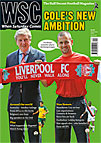 Neil Andrews tracks the development of the bench and can't help but feel shortchanged by its most recent incarnation
Neil Andrews tracks the development of the bench and can't help but feel shortchanged by its most recent incarnation
Change is meant to be a good thing but it can go hideously wrong. Take the humble substitutes' bench. Once the bastion of the 12th man and his manager, it is now an overcrowded, characterless affair packed full of reserves in club tracksuits who look like they're serving double detention after being caught smoking behind the bike sheds.
Very few grounds still have the tight, compact boxes once seen at Highbury and Old Trafford. Fewer still have the concrete shelters that provided many a manager and his assistant with the perfect view at pitch level. Meanwhile, the Perspex shell that was pioneered by Subbuteo in the 1970s is only really seen at major tournaments and provided the backdrop to Fabio Capello’s bizarre bullying of Stuart Pearce during this summer’s World Cup.
Now it is all technical areas and bespoke upholstered seats with the club’s badge stitched neatly into a headrest that wouldn’t look out of place at the local Cineplex. No expense has been spared to make a player’s stay on the bench a comfortable – if not an entirely happy – one. The only thing that’s missing is the little cup holders. However, if I was a fan of a Premier League team I’d be worried that my club was spending the equivalent of a season-ticket making sure the likes of Robbie Keane don’t get a sore bum.
Of course, if one club decides to invest heavily on such home comforts then everyone else has to follow suit, least they be left out or mocked by visiting teams. As a result the benches at most top grounds have become soulless replicas, only identifiable by that cushion emblem, where the same miserable faces sit – legs crossed if you’re the boss, elbows on knees with head in hands if you’re one of his valued backroom staff on the front row.
Probably the worst bench of the lot is the one at Old Trafford. I can just about live with the padded armchairs, but there’s no excuse for the type of red-brick monstrosity normally seen in a suburban housing estate. All it needs is a disabled access ramp to go with the stairs and handrails and it could be the entrance to the local surgery, particularly when Sir Alex is furiously chewing gum and checking his watch as if he’s waiting for it to open, complaining to the balding bloke next to him all the while.
It’s a far cry from when The Big Match cameras would home in on the likes of Brian Clough and Peter Taylor as they popped out of their concrete bunker to yell instructions and furiously shake their fists at no one in particular, before disappearing from view again. But even those whitewashed and no doubt musty shelters were a comparative luxury when Nottingham Forest first won the European Cup in 1979. They didn’t even have the comfort of a bench that night, having to make do with a row of plastic chairs next to the running track, laid out as if in readiness for the headmaster and teachers before the annual sports day. Yet somehow one of the most enduring images of that game is of Clough and Taylor taking their seats in their matching sky-blue jumpers and shirts.
And that’s kind of the point. Yes, the new improved “benches” offer comfort that would be unimaginable to those who endured the plain wooden pews that were open to the elements at Molineux. They simply don’t offer the kind of snapshots that define an age or manager the way the old dugouts did. You can’t imagine Sir Alf Ramsey sitting stoically in a World of Leather cast-off as England won the World Cup. It says a lot when the most iconic managerial image of recent times was of Steve McClaren standing forlonly with his brolly. And that only came about because his seat was soaking wet.
From WSC 283 September 2010